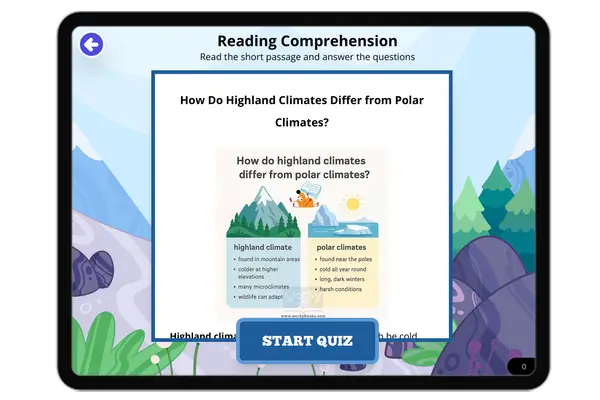What Is a Temperate Climate? — Passage
A temperate climate is a type of climate that has mild to moderate temperatures with distinct seasons. It is not extremely hot or extremely cold, which is why many people around the world live in temperate zones. This climate is found between the tropical and polar regions of Earth.
In temperate climates, there are usually four seasons: spring, summer, autumn (fall), and winter. Summers can be warm or hot, while winters are cool or cold—but not as cold as polar regions. The amount of rainfall is moderate and spread out during the year, helping plants grow well in these areas.
There are three main types of temperate climates:
● Oceanic (marine): Found near the coast, this climate has cool summers and mild winters with plenty of rainfall. Examples include parts of western Europe and the Pacific Northwest in the U.S.
● Mediterranean: This climate has hot, dry summers and cool, wet winters. It is found in places like California, southern Europe, and parts of Australia.
● Continental: Found farther from oceans, this type has hotter summers and colder winters. It includes areas like central and eastern Europe, much of the U.S., and parts of Asia.
Temperate zones are great for farming because of the regular rainfall and mild temperatures. Crops like wheat, apples, and grapes grow well in these regions. Many forests, grasslands, and rivers are also found in temperate areas, making them rich in biodiversity.
Fun Fact: Most of the world’s major cities, like New York, Tokyo, Paris, and Beijing, are located in temperate climate zones!
What is a key feature of temperate climates?
Always hot and rainyAlways cold and snowyMild temperatures with four seasonsNo rainfall or seasonsHow many seasons does a temperate climate usually have?
OneTwoFourSixWhich of the following is a type of temperate climate?
TundraOceanicTropical rainforestDesertWhat is special about Mediterranean climates?
They have snow year-roundThey are hot and wet all yearThey have dry summers and wet wintersThey are always cold and dryWhere are continental climates usually found?
Near the oceanAt the North PoleIn deep forests onlyFar from oceans, with hotter summers and colder wintersWhy are temperate zones good for farming?
They have no rainfallThey are close to volcanoesThey have mild weather and regular rainfallThey don’t have animalsWhat is the main idea of the passage?
Temperate climates are bad for livingTemperate climates are found only in AsiaTemperate climates have moderate temperatures and four seasonsTemperate climates are too rainy for plantsWhich of these cities is in a temperate climate zone?
CairoTokyoNuukBangkok








